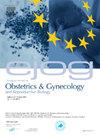Ferric carboxymaltose for iron deficiency in twin pregnancies: A single center 10-year retrospective longitudinal pre-post study
IF 2.1
4区 医学
Q2 OBSTETRICS & GYNECOLOGY
European journal of obstetrics, gynecology, and reproductive biology
Pub Date : 2025-05-27
DOI:10.1016/j.ejogrb.2025.114084
引用次数: 0
Abstract
Background
Iron demand is almost double and anemia prevalence four times higher in twin pregnancy. There is limited information on the impact of antenatal intravenous iron (IVI) on maternal hemoglobin in women pregnant with twins.
Objective
The main objective was to assess the safety and efficacy of IVI in twin pregnancy. The secondary objective was to analyze the impact of intraoperative cell salvage as an additional Patient Blood Management (PBM) tool.
Study Design
Single center retrospective longitudinal pre-post study of all women, pregnant with twins, receiving intravenous Ferric Carboxymaltose (FCM) between 2013 and 2023.
Results
One hundred nineteen women were included in the analysis. Mean ferritin values prior infusion was 10.9, 12.9, 15.3, and 15.4 µg/L in the severe, moderate, mild and no anemia group respectively. Post infusion mean hemoglobin increased by 21.6 g/L, 13.4 g/L, 11.0 g/L, and 6.8 g/L in the respective groups. No serious adverse events were reported. Forty-four (36.9 %) suffered a postpartum hemorrhage (mean blood loss 1278 ml). Seventeen women received red blood cells. Five had an allogeneic transfusion whereas twelve had cell salvaged autologous re-infusion. Post IVI hemoglobin was negatively correlated with length of stay.
Conclusions
We observed a significant increase in antenatal hemoglobin and restored iron status in twin pregnancies in response to IVI. Low allogeneic red blood cell transfusion rates were achieved by combining iron infusion with the utilization of cell salvage technology and autologous reinfusion as part of our Obstetric PBM approach.
羧基麦芽糖铁治疗双胎缺铁:单中心10年回顾性纵向前后研究
双胎妊娠对铁的需求量几乎增加了一倍,而贫血患病率则高出四倍。关于产前静脉注射铁(IVI)对双胞胎孕妇血红蛋白影响的信息有限。目的评价体外受精在双胎妊娠中的安全性和有效性。次要目的是分析术中细胞回收作为额外的患者血液管理(PBM)工具的影响。研究设计对2013年至2023年间接受静脉注射羧麦芽糖铁(FCM)治疗的所有怀双胞胎的孕妇进行单中心回顾性纵向研究。结果119名女性被纳入分析。重度、中度、轻度、无贫血组患者输注前铁蛋白平均值分别为10.9、12.9、15.3、15.4µg/L。各组注射后平均血红蛋白升高21.6 g/L、13.4 g/L、11.0 g/L、6.8 g/L。无严重不良事件报告。44例(36.9%)发生产后出血(平均出血量1278 ml)。17名女性接受了红细胞注射。5例接受同种异体输血,12例接受挽救细胞的自体再输注。IVI后血红蛋白与住院时间呈负相关。结论:我们观察到双胎妊娠对IVI的反应显著增加了胎儿血红蛋白和恢复了铁状态。作为产科PBM方法的一部分,通过铁输注与细胞挽救技术的利用和自体再输注相结合,实现了低异体红细胞输注率。
本文章由计算机程序翻译,如有差异,请以英文原文为准。
求助全文
约1分钟内获得全文
求助全文
来源期刊
CiteScore
4.60
自引率
3.80%
发文量
898
审稿时长
8.3 weeks
期刊介绍:
The European Journal of Obstetrics & Gynecology and Reproductive Biology is the leading general clinical journal covering the continent. It publishes peer reviewed original research articles, as well as a wide range of news, book reviews, biographical, historical and educational articles and a lively correspondence section. Fields covered include obstetrics, prenatal diagnosis, maternal-fetal medicine, perinatology, general gynecology, gynecologic oncology, uro-gynecology, reproductive medicine, infertility, reproductive endocrinology, sexual medicine and reproductive ethics. The European Journal of Obstetrics & Gynecology and Reproductive Biology provides a forum for scientific and clinical professional communication in obstetrics and gynecology throughout Europe and the world.

 求助内容:
求助内容: 应助结果提醒方式:
应助结果提醒方式:


